Évora is a historical city located in the interior of Portugal and the capital of the Alentejo region. Évora is full of things to see from a Roman temple to a chapel built with real human bones, the abundance of well-preserved historical sights making the city a UNESCO World Heritage Site.
The whitewashed houses of Évora, decorated with ochre details, form such a cohesive look that the city is often called a living museum. The narrow alleys of the old town surrounded by ancient city walls, the granite arches and several churches and convents give the final touches to the unique atmosphere of Évora, a city that breathes past centuries.
The various restaurants of Évora call for tasting the best known delicacies of the rural Alentejo region, such as traditional dishes, black pork, cheeses, olive oils and, of course, wines. The cuisine makes Évora a perfect destination for culinary and culture lovers.
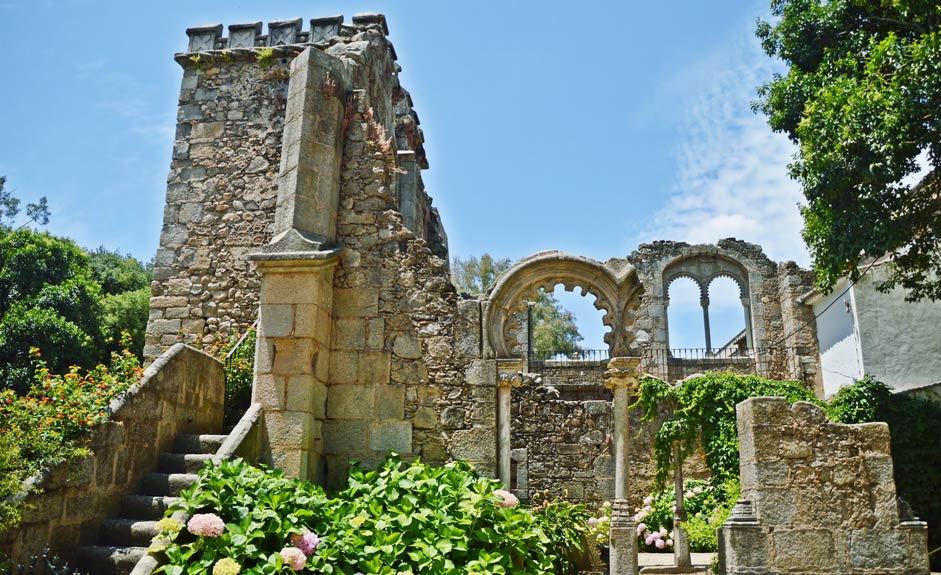
Comfortable accommodation inside the city walls – where to stay in Évora
The city of Évora is formed by the medieval old town surrounded by 14th-century city walls and the newer parts of the city that are situated outside of the walls. Almost all the sights are centered at the historical town area located inside the walls, so the most convenient option is to stay there. The old town area is pretty compact and can be easily walked around. Walking from wall to wall through the old town takes around 20 minutes.
Évora has accommodation to offer in all ranges, from luxurious theme hotels to holiday apartments in the old town alleys, as well as unique hotels renovated inside historical convents. A little outside the city, there are also inviting accommodations at beautiful country hotels and wine estates. In summertime, the temperatures soar high in Évora, so a hotel equipped with a pool for cooling off during the hottest afternoon hours may be a good idea.
Parking space is very limited on the old town streets, so if arriving by car, it may be necessary to leave it further away from the accommodation. There are large parking lots just outside of the city walls and it is generally safe to park there. If it’s necessary to have the car close by, it may be smart to pick one of the hotels located outside of the old town, since those tend to offer more parking spaces.
Historical sites and culture – What to see and do
Cathedral of Évora
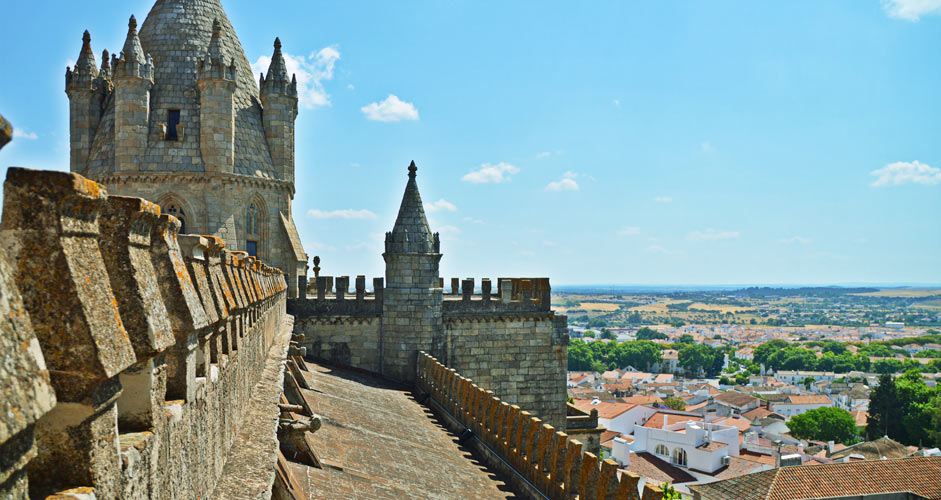
The Roman Catholic Cathedral of Évora is the largest medieval church of Portugal and one of the best examples of gothic architecture. A humble church was built at the site of the current massive cathedral when Évora was re-conquered from the Arabs in the 12th century. The building was enlarged during the next centuries in the early gothic style. Also chapels representing different architectural styles as well as gothic cloisters were added over time. The current glorious main cathedral was almost fully rebuilt in the 18th century.
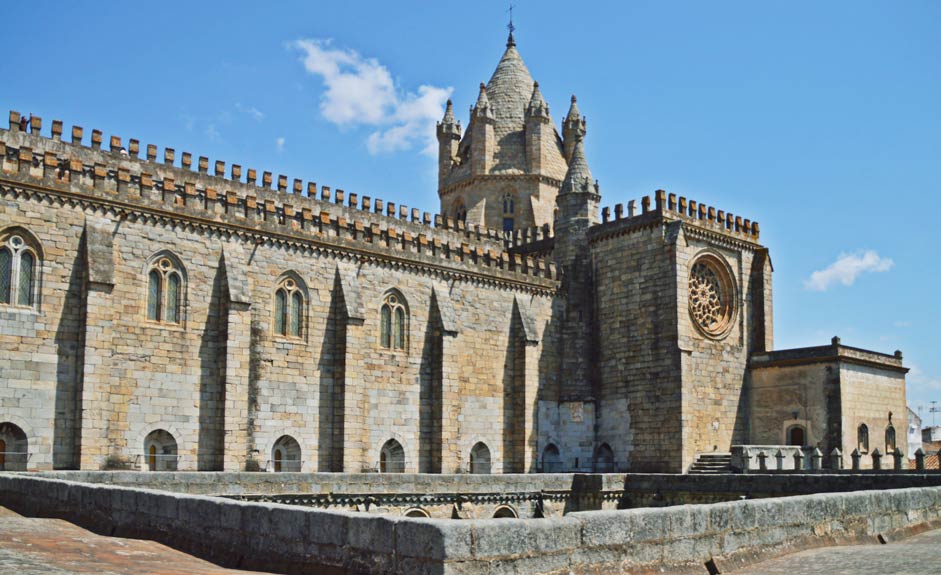
The cathedral has a small entrance fee, the exact sum depending on which sites one wishes to enter in the cathedral area. For those not suffering from claustrophobia or vertigo, it’s recommended to get a ticket that allows entering the cathedral towers, because the views over Évora from the towers and from the roof of the cathedral are priceless. However, the roof can only be accessed by climbing up the steep and cramped spiral stairs.
The cathedral also hosts the Museu de Arte Sacra Cathedral Museum presenting Catholic art. It’s possible to admire a reliquary decorated with 1426 real gemstones, supposedly including pieces of the Christ’s Cross. Another famous piece of art is an ivory statue of Mary made in the 13th century France, opening up like a puzzle and revealing an elaborate triptych of her life.
The Roman Temple of Évora
The Roman Temple of Évora is one of the most well preserved and largest Roman-era buildings in the Iberian Peninsula. It has been built on the 2nd century AD on the main plaza of Évora at that time, the forum. The temple was most likely built to commemorate the Roman emperor Caesar Augustus who was venerated as a god during and after his reign. The Corinthian temple standing on the Largo Conde de Vila Flor square was for a long time erratically thought to be built in honor of Diana, the ancient Roman goddess of moon and hunting, and therefore the temple was also called Temple of Diana.
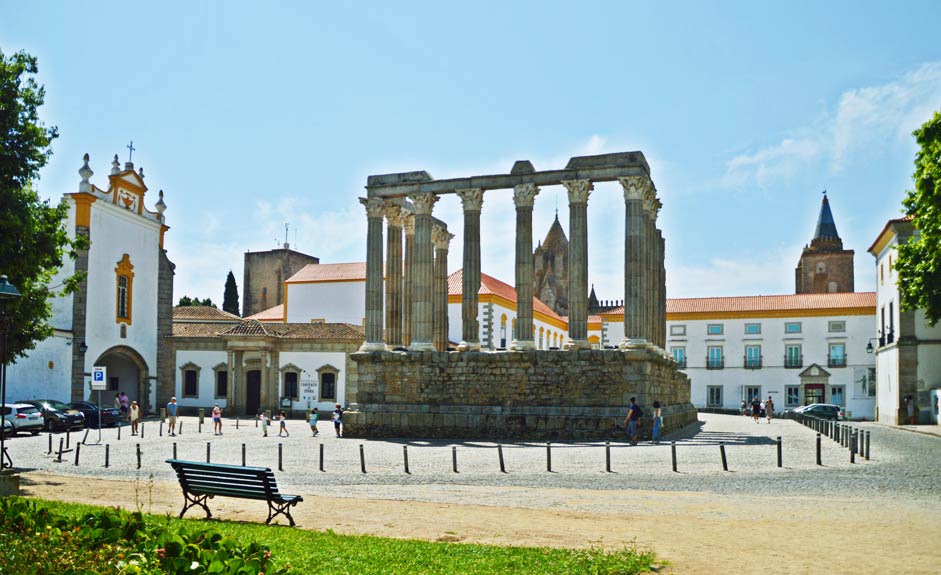
The Roman Temple of Évora suffered losses in the conquering wars of the 5th century, and since the medieval times, it has had many purposes, serving as a strongroom, bull fighting arena as well as a butcher shop. Restored in the 20th century, the base of the temple has remained intact and 14 of the Roman pillars are still standing. The temple is surrounded by medieval buildings that belonged to the inquisition of Portugal, such as palaces, cathedral, convent and a courtroom.
Jardim Diana park is located next to the Roman Temple and has gorgeous views over Évora and the surrounding rolling countryside of Alentejo. There is no entrance fee to the temple. Climbing on the ruins is not allowed.
Termas Romanas
Évora experienced a surprise when the Roman-era spa Termas Romanas was found under the city hall in 1987. Built in the 1st century, the spa consists of the ruins of laconicum, a steam bath with a diameter of 9 meters, as well as remains of a heating system and an outdoor pool. All of them have once been located in the largest building of the city.
Today the Termas Romanas of Évora can be admired at the city hall (Câmara Municipal) for free. The place is open from Monday to Friday during office hours. The address is Praça do Sertório.
Igreja de São Francisco and Capela dos Ossos
The Church of St. Francis was built starting in the late 15th century to replace a former church building located on the site. The large church represents gothic style, but has been influenced also by Arabic architecture.
Évora and the Igreja de São Francisco are especially known for the macabre side chapel, featuring walls built with real human skulls and bones. The small chapel is called Capela dos Ossos, the Chapel of the Bones. It was built in the 18th century by three Franciscan monks to remind people about the fragile and temporary nature of human life. A message has been scripted above the door: “Nós ossos que aqui estamos, pelos vossos esperamos”, meaning “We bones that are here, await yours”.
The bones neatly positioned on the chapel walls are from 5000 corpses that were exhumed from the graveyards of the nearby churches. The lugubrious sight also features two female mummies, one of a child, that used to hang on the chapel walls until the beginning of the 21st century.
The entrance fee to the Chapel of the Bones costs a couple of euros. With the same tickets it’s also possible to visit a museum exhibiting religious art from Portuguese painters and sculptors, as well as getting to know a collection of different Catholic objects.
More information: igrejadesaofrancisco.pt
Évora Museum – National Museum of Friar Manuel do Cenáculo
The Évora Museum presents the history of the region from Roman-era objects to 18th century art. The compact museum consists of several different exhibitions concentrating on art, archeology, natural history and science.
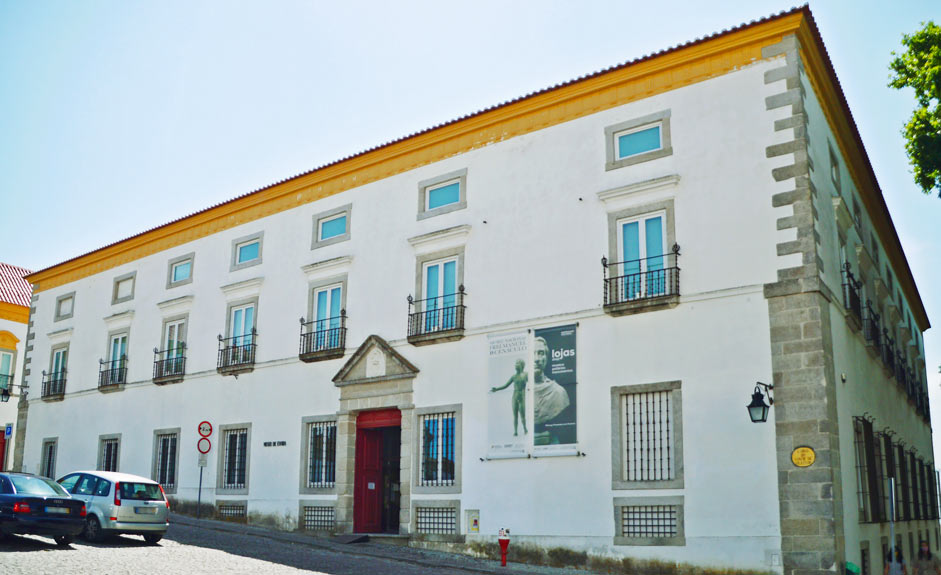
The most important pieces of the museum are the polyptych paintings from Sé Cathedral and the works of Portuguese artists, but also the archeological findings from the antique era. The museum is built in the Amaral Palace and located on the Largo Conde do Vila Flor square.
Praça do Giraldo
On summer weekends, the main square of Évora called Praça do Giraldo, wakes up only after the hot sun has set, filling up with people. Lined by historical buildings, the 16th century square also features a beautiful baroque fountain sculpted of marble. The square has been paved with the traditional Portuguese calçada pavement. Praça do Giraldo has gotten its name from Geraldo Geraldes the Fearless, who re-conquered the city of Évora back from the Moors in 1167.
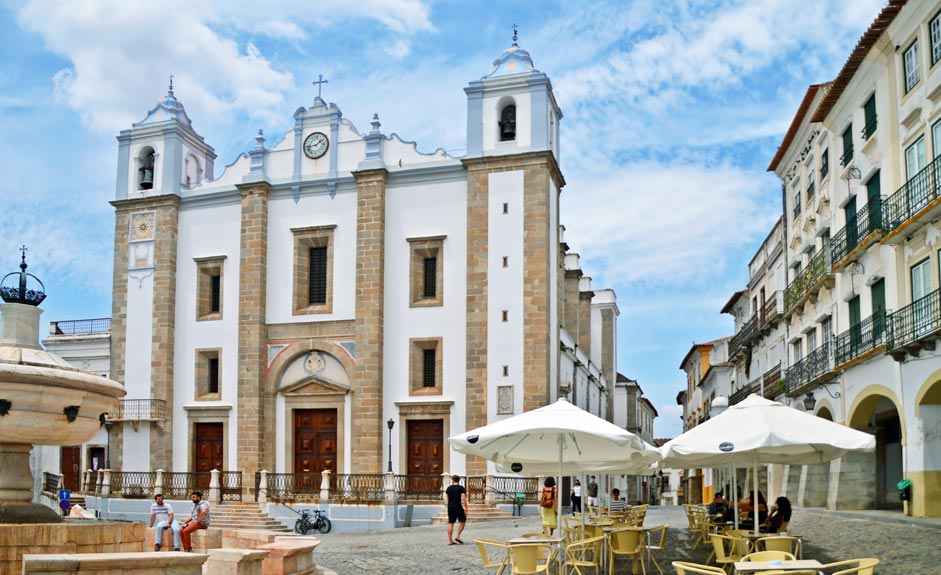
The square became a national monument in 1910, and it has several important buildings on its sides, including the Igreja de Santo Antão church and the Portuguese state bank housed in a historical building. Praça do Giraldo also has many nice restaurants and cafés with outdoor patios, as well as shops, banks and the tourist information office of Évora.
Igreja da Misericórdia
Évora is known for its churches, the baroque style Igreja da Misericórdia being one of the prettiest. The 16th century church has a rococo marble door, looking otherwise humble on the outside, but the golden altar, wall frescoes and the walls of hand-painted blue and white azulejo tiles make the visit well worth it. The wall tiles have been painted by the Lisbon-based tile artist António de Oliveira Bernarde in 1715 and they make the unique church an experience not to forget.
Igreja da Misericórdia is located on the Largo da Misericórdia square, shaded by the jacaranda trees and offering a welcome moment of cooling in the hot weather of Évora. No entrance fee.
Évora Public Park - Jardim Público
Évora is a boiling hot place in the summer months, but the shaded garden of Jardim Público is a cooling oasis in the middle of the city. By the fountains it’s possible to watch the life of ducks and free-roaming peacocks or head for a walk towards the shady picnic area. In the park there are also faux ruins and a playground for kids. The park extends partly on top of the city walls of Évora.
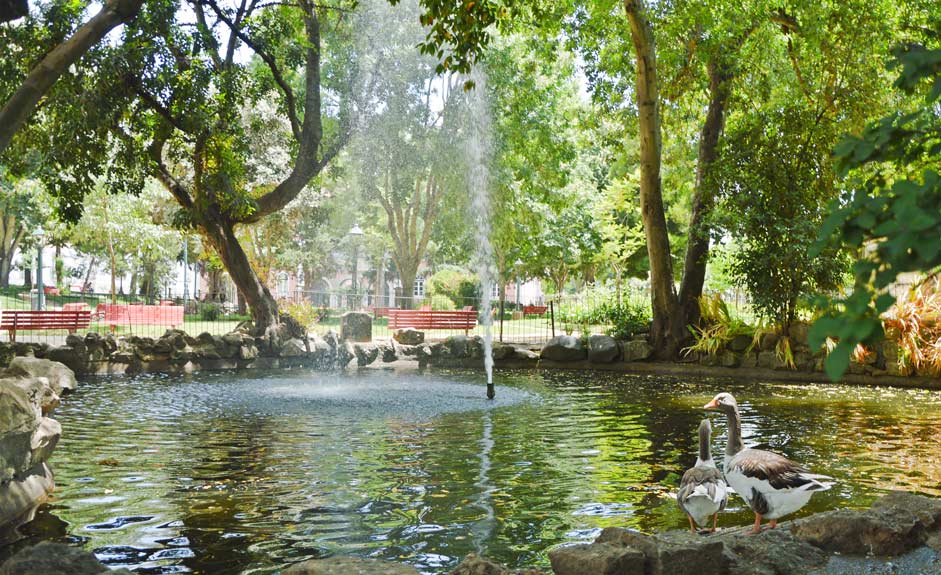
Porta de Moura Square
The occupation of the Arabic Moors left its mark in Évora, and the Largo da Porta de Moura Square has been named after an Arabic gate that once was located there. Only parts of the gate remain, but the square is home to another sight as well – a renaissance fountain. Its marble orbit is shining beautifully white, even though the fountain dates back to the year 1556 and acts mostly as a traffic divider these days.
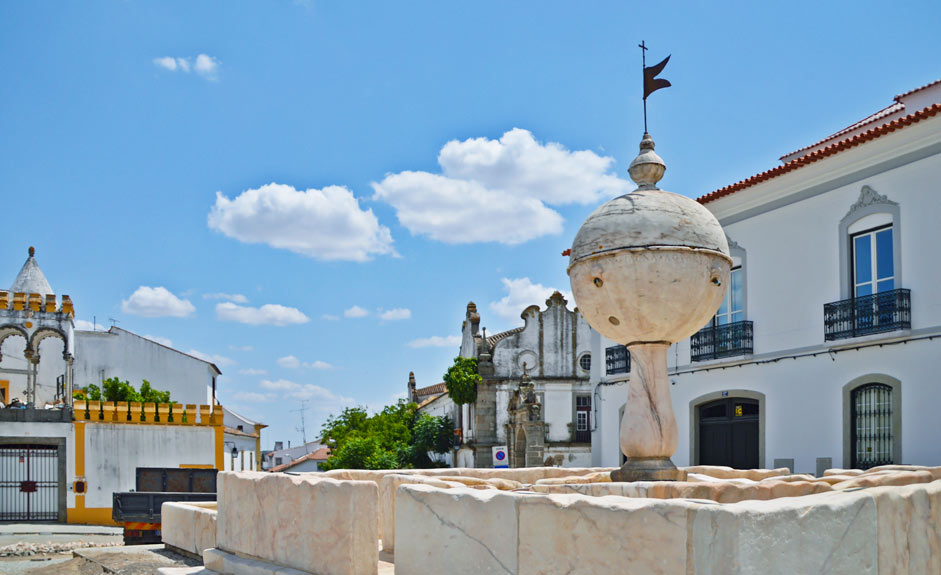
Água de Prata Aqueduct
The Aqueduct of Água de Prata is a remarkable example of the 16th century engineering work and one of the largest and most important monuments of Évora. The aqueduct is 18 kilometers long and it was built to transport water from the fountains located further away to the city of Évora that suffered from lack of water. The renaissance arches have most probably been built upon a former Roman aqueduct. The aqueduct is still in use, contributing to the water supply of the city.
Houses have been built between the aqueduct arches inside the walls. Some of the houses are merely façades, while others are still inhabited. The houses can be admired on the Rua do Cano street and its surroundings. A renaissance water box located on the Rua Nova street has also been a part of the aqueduct and easily distinguished by its 12 decorative pillars.
Convent of Cartuxa
The Convent of Cartuxa, also called Mosteiro de Santa Maria Scala Coeli, is a medieval convent located a kilometer outside of the old city walls of Évora. The renaissance marble façade, golden altar and the largest cloisters of Portugal are well worth a visit.
The convent was built between 1587 and 1598 by the archbishop Teotónio de Bragança. In the 19th century, the Carthusian monks were expelled from the monastery by rebels, and the convent was turned into an agricultural school, the church acting as grain storage. Later the convent was acquired by the family of Eugénio de Almeida, who renovated it, enabling the return of the only community of Carthusian brothers of Portugal in the 1960’s. The four last Carthusian brothers, already aged, moved to another convent in Spain in 2019, after which the convent has been inhabited by a community of Catholic nuns.
The Convento de Cartuxa is an active convent and a great place for contemplation and silence. The Cartuxa winery is also located at the convent.
The Cadaval Palace
The Palácio dos Duques de Cadaval is located in the old town of Évora, next to the Roman Temple. The palace has been built in the 14th century on the ruins of a castle destroyed in a fire, and its architecture is a mixture of Arabic, gothic and Manueline styles. The palace also features the massive Torre das Cinco Quinas tower.
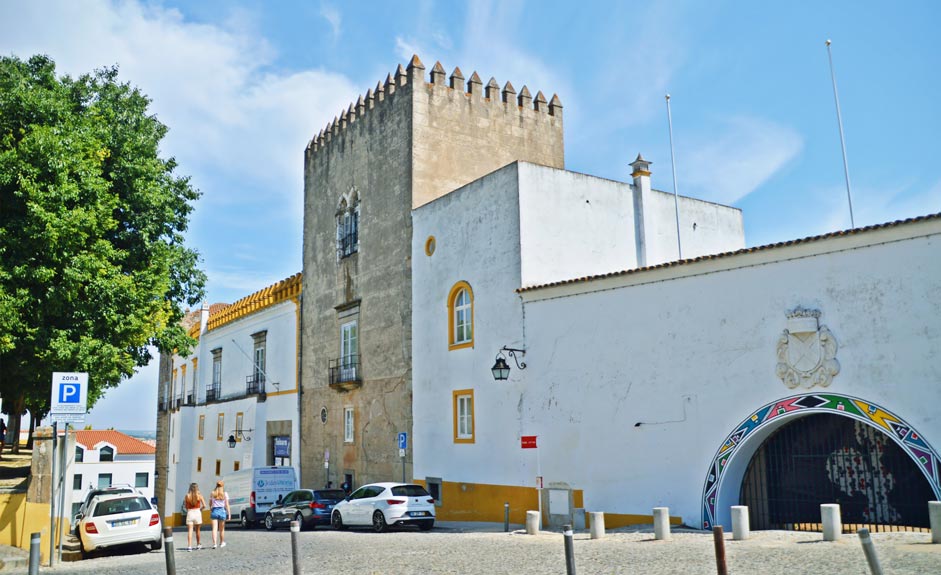
The palace belongs to the Duke family of Cadaval and despite the private ownership some of the floors can be visited. The palace hosts old scripts, family portraits and religious art from the 16th century, among other interests. Sometimes there are cultural events in the palace and the garden also boasts a restaurant.
More information: palaciocadaval.com
University of Évora
Évora is known as a student city, hosting the second oldest university of Portugal. It has been founded in 1559 by the Cardinal Infante dom Henrique. The university was a Christian school for over two hundred years, being closed in the 18th century. It was reopened only in 1973. Nowadays the University of Évora is a public institution functioning within historical walls and offering dozens of modern study programs.
The University of Évora consists of several historical buildings, but especially the main building, Colégio do Espírito Santo, has a gorgeous façade featuring marble cloisters and an old chapel situated between them. There are many historical paintings in the building and many classroom walls have been decorated with baroque-style azulejo tiles, with themes ranging from study subject representations all the way to Plato or Aristotle teaching their students.
The interior of the university can be freely explored also during office hours, as long as the teaching is not disturbed or spaces with prohibiting signs entered. There are also guided tours available for booking.
More information: uevora.pt
Interesting day trips from Évora
Almendres Cromlech
In the middle of the rolling cork oak woodlands of Alentejo, on a gentle slope, there is an opening with dozens of mystical stones standing in a circle-like formation. The place is an ancient megalithic complex, consisting of monoliths erected some 6000 years BC. The Almendres Cromlech is the largest menhir construction in the Iberian Peninsula. Some of the stones still exhibit carved drawings, and a few have tiny round holes that have probably been used for astronomical tracking by placing small stones in them.
The Évora region has been inhabited since the Stone Age, and is home to several smaller menhirs that are scattered in the countryside. The Almendres Cromlech has probably been a place for celebrations and ceremonies, or alternatively, a place for observing the sky. Approximately 1.5 kilometers from the Cromlech, there is also a single large menhir, erected roughly on the line pointing towards the sunrise in the Winter solstice.
The place is located close to the village of Nossa Senhora de Guadalupe, west of Évora. It’s well worth stopping by when traveling between Évora and Lisbon. There is also a visitor center by the road. There is no entrance fee for visiting the Cromlech.
Montemor-o-Novo
Montemor-o-Novo is a picturesque small town west of Évora and a nice day trip destination from Évora or even from Lisbon. It has a lot to see from historical churches to convents, and the enchanting cobble stone alleys allow for diving deep into the charm of the past centuries.
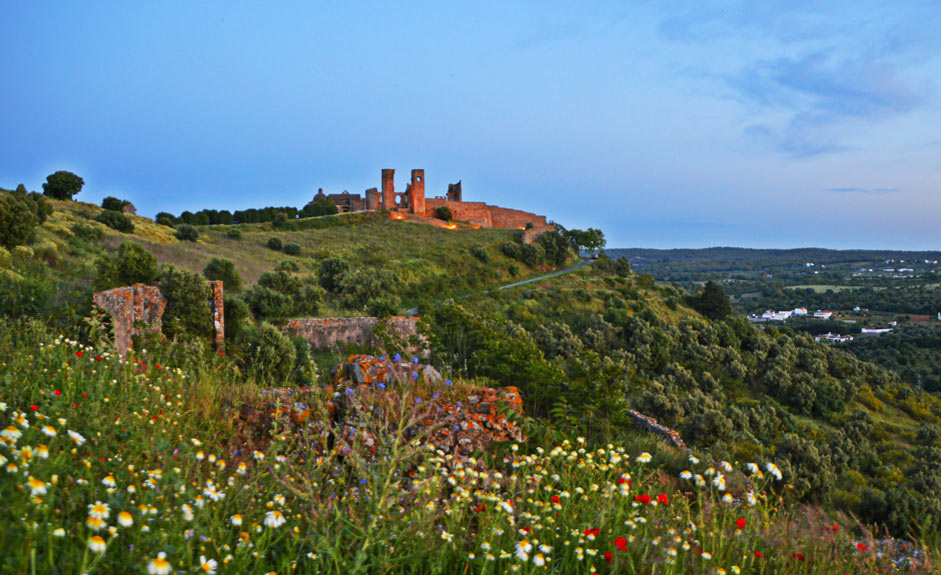
The main sight of Montemor-o-Novo is the medieval castle in ruins, standing atop of a hill. The castle was built on a previously existing Moorish fortress and has seen many battles along the centuries. The Saudação Convent of the castle is a great place for admiring gorgeous cloisters and fresco paintings. The place is especially beautiful during the sunset hours.
Arraiolos
The village of Arraiolos is known for embroidered wool carpets, famous in all of Portugal. They are one of the oldest craft forms of the country that are still very popular. The Arraiolos carpets are hand-woven and decorated with colorful floral patterns. In May, the festival O Tapete Está na Rua is organized in Arraiolos, celebrating this craft form and the local culture.
The sights of Arraiolos also include a peculiar round castle dating back to the 15th century, as well as the Convento dos Loios. The convent features a baroque church with interiors decorated with azulejo tiles and golden details. The village is located some 20 kilometers north of Évora.
Vineyards
Wine has been cultivated in Alentejo since the Roman times, and today the wines of the region are not only famous in Portugal, but also internationally more and more known and praised. Even though the wine bars and restaurants of Évora are a great place for indulging the wines, the atmosphere of the wineries located on the countryside is unique. It’s easy to do a day trip from Évora to one of the several vineyards of the region, to taste the fruity whites, rich reds and fresh rosés, served with traditional Alentejo food or snacks. Many vineyards also offer accommodation, ranging from simple country living to luxury.
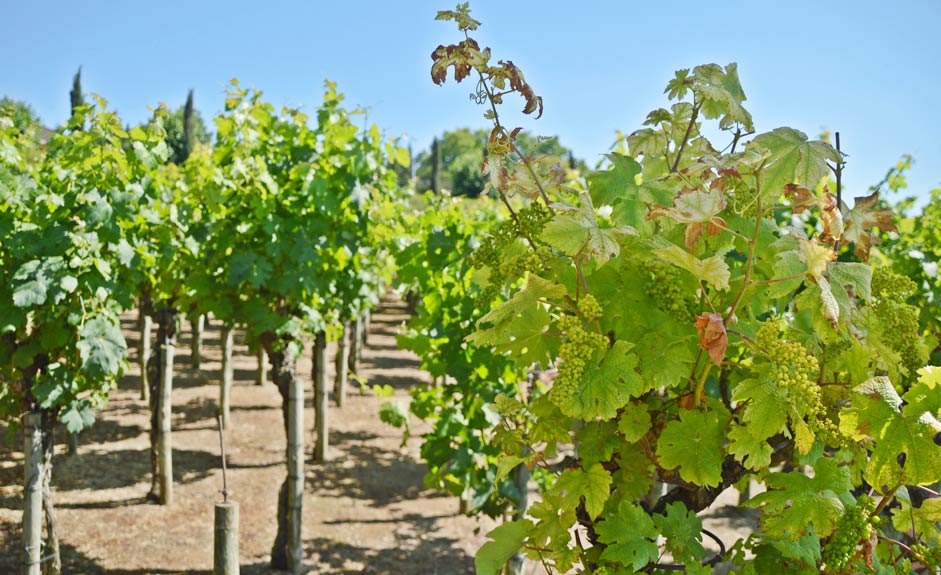
Évora is also a great starting point for heading out to explore the Alentejo Wine Route, Rota dos Vinhos do Alentejo. Dozens of inviting vineyards located in the rolling landscaped of the region with different grape varieties make choosing the ones to visit a tough choice, but luckily, there aren’t really any bad wines to be found in the region.
Alentejo cuisine and regional wines – What to eat
Évora is an amazing destination for a culinary holiday, because despite the small size of the city, the area boasts hundreds of restaurants. It would be easy to spend a week or three tasting the menus of all the restaurants. The unique gastronomy of the Alentejo region is strongly based on the trinity of wheat bread, olives and wine, complemented especially by pork and lamb meats as well as sheep milk cheeses. The food is the simple but tasty fare of the poor agricultural region, offering endless chances to compare the flavors of different cheeses and olive oils.
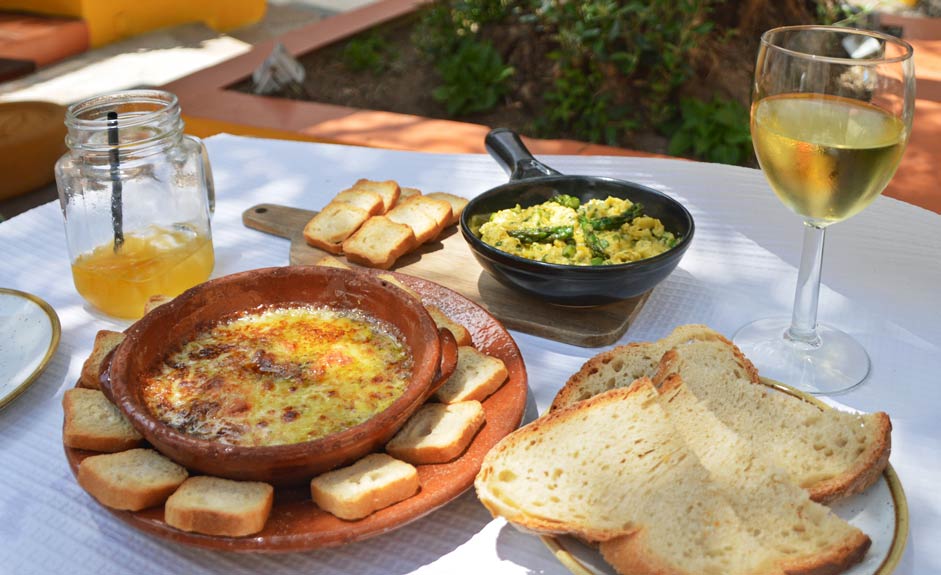
One of the best known dishes of Alentejo is the açorda, a love child of puré and soup made with bread, olive oil and garlic and relished in several ways. Açorda á Alentejana, on the other hand, is a soup of clear broth topped up with bread slices, poached egg and spices such as garlic and coriander. Migas is a traditional dish resembling stir-fry, made with breadcrumbs fried in butter and different ingredients that vary by the season. The Portuguese tapas, petiscos, offer some delicious dishes to try, for example eggs with asparagus and a grilled local cheese topped with olive oil and herbs. The Évora cheese is a small and round, hard-ripened sheep milk cheese that has been awarded the DOP nomination.
The black pigs of Alentejo that roam freely in the oak forests eating acorns are called porco preto. Their meat provides delicious steaks, different sausages such as paiola and presunto, the cured ham. All parts of the animals are being utilized, so the most peculiar body parts can come up in the restaurant menus. Also river fishes and dogfish soup are commonly eaten in Évora.
It’s possible to find sweet lard pastries, pasteis de toucinho, in the bakeries of Évora. Other desserts worth trying are queijadas de Évora cupcakes and the Queijinho do Céu pastries, “little heavenly cheeses” resembling marzipan and filled with egg custard. Eggs, almonds and pumpkin are some of the main ingredients of the traditional bakery products in Alentejo.
Alentejo is the leading wine production region of Portugal and has many local grape varieties, too. The regional wines keep their top positions in the rankings year after year and enjoy a growing international interest as well. Thus, Évora is a perfect place to learn about the world of enology and taste different types of regional wines.
Évora is a great place for shopping the diverse products of Alentejo
The old town of Évora is a comfortable environment for shopping. The hustle and bustle of larger cities is completely absent, allowing one to explore the shops of Évora in a tranquil country town atmosphere and escape the afternoon heat into the air-conditioned stores. There are shops for all tastes, ranging from trendy newcomers to chain stores and traditional boutiques. The best shopping streets of the town can be found around Praça do Giraldo.
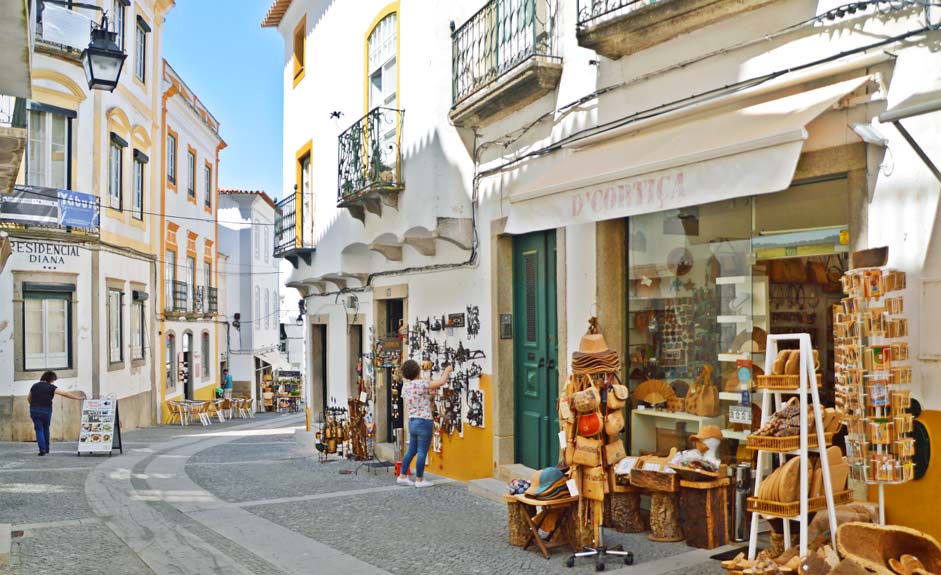
The Mercado Municipal market of Évora is located on the 1º de Maio square and is a great place for stocking up on groceries directly from regional producers, ranging from fish to vegetables. It features a café and some souvenir stalls as well. The market is a great place to buy food items of Alentejo to take back home, such as olive oil, wines and cured cheese and meat products requiring no refrigeration.
Alentejo is the largest cork producer of the world, making cork products that range from traditional items to contemporary accessories an excellent souvenir choice. The cork is harvested from the surface of the cork oaks without harming the trees, which makes it an ecological product. The colorful furniture of Alentejo, woven carpets and bedspreads as well as painted ceramics are some popular souvenirs, too. The region also produces high quality leather products from daily items to beautiful shoes and bags, as well as many other crafts made with a variety of materials. Souvenir stores selling handcrafts are centered on the Rua 5 de Outubro street.
Évora also boasts a modern shopping mall called Évora Plaza, located a couple of kilometers outside of the old town. It features many shops, a large supermarket, a food court and a cinema.
How to get there from Lisbon
Évora is located some 130 kilometers east of Lisbon, the closest international airport being in Lisbon. Évora is easily accessed by rental car, because the A6 highway connects the city to the capital, and only the last 12 kilometers are covered on a regional road. The highway is in a very good shape but has road tolls. The journey takes between 1h15min to 1h30min. The same A6 highway continues all the way to the border of Spain.
The train journey from Lisbon to Évora takes one and a half hours with the intercity train of Comboios de Portugal. The train stops at Oriente, Entrecampos, Sete Rios and Pragal stations and the one-way ticket price is from 12 to 17 euros, depending on the class. For example the Oriente train station has a fast connection to the Lisbon airport on the red metro line.
The buses are in the same price range as the trains, the journey taking from 1h30min to 1h45min. The national bus company is called Rede de Expressos and the buses depart from the Sete Rios and the Oriente train stations.
Weather and climate in Évora
The climate of Évora and the surrounding Alentejo region is a mixture of Mediterranean and continental climates, known for the dry summers of extreme heat and cool, inconsistently rainy winters. The temperature differences between day and night are also considerable.
Winter: The highest temperature of the day is around 14 °C in the wintertime, dropping to 5-6 °C at night and even close to zero on very cold nights. Évora receives most rains between October and January.
Spring: The springtime temperatures are comfortably warm, making the time between March and May a pleasant time to get to know Évora. Daytime temperatures are usually on the better side of 20 °C, dropping closer to 10 °C at night. It rains somewhat in spring.
Summer: The Alentejo summers are hot, the average highest temperature of the day being 32 °C in July-August. At night it’s a lot cooler, the temperature dropping down to 16-17 °C. The region is susceptible to heat waves of over 40 °C. The summer months are usually very dry, making Évora a very sunny city.
Autumn: September is still a hot summer month, the temperatures starting to decrease in October, when the winter rains also usually start. A comfortably warm time to visit Évora in the autumn is from the end of September until mid-October.
---
Text and photos: Johanna Maldonado








